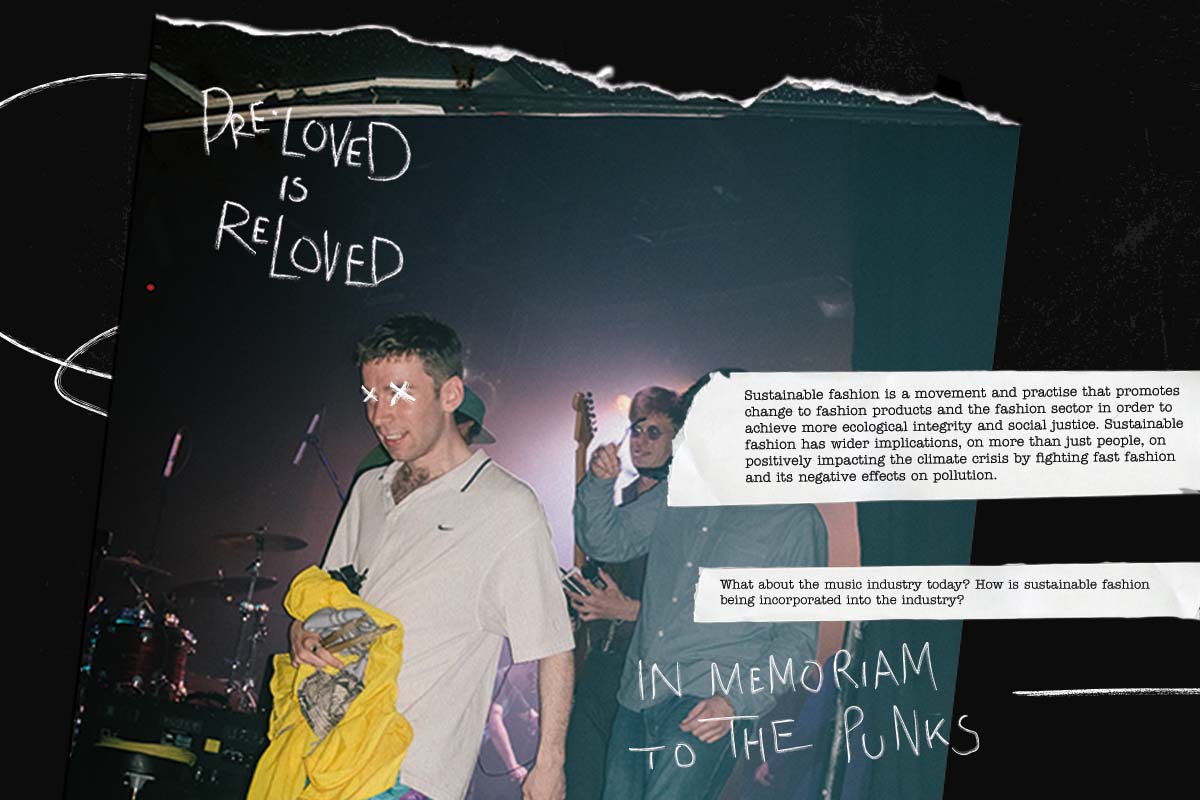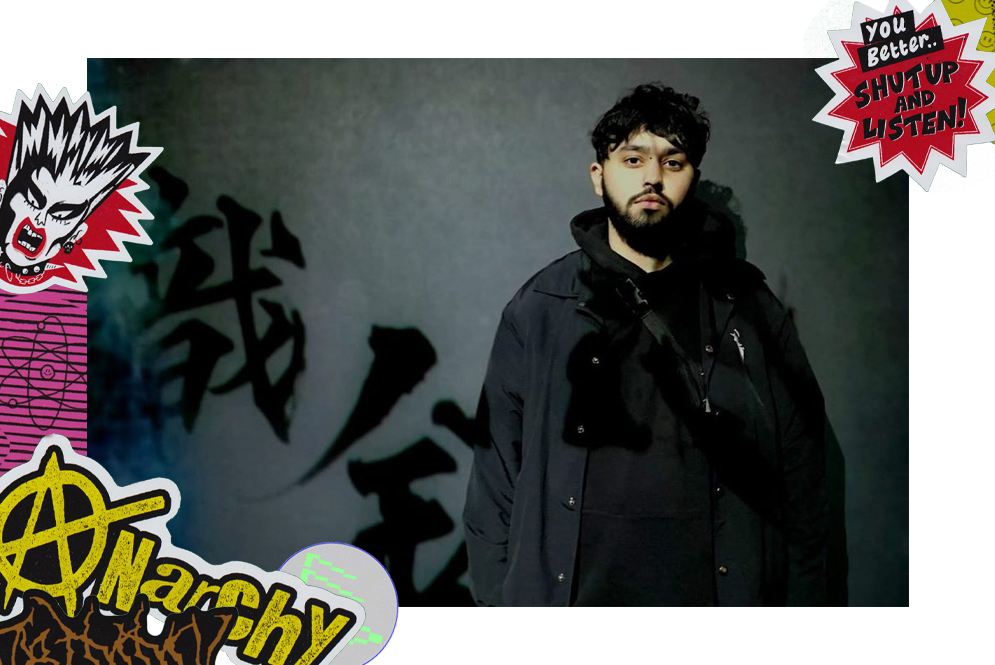As part of our Music Made Us campaign, creatives, music professionals, experts and journalists reflect on how music has been there for us through good times and tumultuous periods that inspire change. Throughout generations, music has sparked, supported and commented on movements, memories and moments in time.
Our contributors explore these events’ relationship with music – from slavery in the 1800’s to the UK’s 80s acid house and rave scene and the 1992 LA riots. Here, Isabelle France explores the relationship between different music scenes and the fashion industry and how we can all strive to be more sustainable.
Sustainable fashion is a practice that promotes change to fashion products and the fashion sector, aiming to achieve more ecological integrity and social justice. Sustainable fashion has wider implications on people and positively impacts the climate crisis by fighting fast fashion and its adverse effects on pollution.
In 1962, biologist Rachel Carsen published her book ‘Silent Spring’ which concentrated on the extensive contamination caused by chemicals that are still in use today; due to this, the sustainable fashion movement and the modern ecological movement both began to emerge at the same time. The use of natural materials became popular in the 60s thanks to the start of rebellious movements. The punk movement made vintage and second-hand clothing popular as it was composed mainly of deprived working-class youths. Grunge then spun their own take on punk and hippie fashion combined due to the 1990s recession.
In today’s fashion industry, pollution has become a severe concern becoming the second-largest polluter globally after the oil industry. In 1987, UNESCO created a definition of sustainability: “development that meets the needs of the present without compromising the ability of future generations to meet their own needs.” Due to the current increasing concern surrounding the climate crisis, brands and companies will hopefully start to take even more action than they do now.
Punk’s DIY Fashion
Within music, the thrifted and charity shop clothing trend started with the punk movement in the mid-1970s. Punks raged against traditional conceptions of gender, family, and hierarchy, with clothing serving as the most visible indication of this. Punk embodied a do-it-yourself approach to fashion as a protest to the commercialisation of the 70s’ post-modernism. Punks wore a mix of recycled clothing, often bought from charity shops that they would demolish, rip, and deface to be seen as anti-fashion rather than the pristine fashion favoured by the upper class. Some punks bought t-shirts or plaid shirts and wrote political slogans, band names, or other punk-related phrases on them with marker or bleach. Punk rock was an intended rejection of the perceived excess and pretension present in the mainstream media, and it may be viewed as a statement of revolt.
Could this readymade, manufactured punk fashion be classed as proper punk fashion if it’s not DIY?
However, like most trends, the punk scene was commercialised by designers such as Vivienne Westwood and Malcolm McLaren. Even though the punk-inspired clothing for their London shop SEX became iconic, could this readymade, manufactured punk fashion be classed as proper punk fashion if it’s not DIY? While it’s quick and easy to replicate pieces of punk fashion like ripped jeans, tartan, and frayed hems – which have now become integrated into mainstream fashion – we forget the roots of these pieces, a politicised movement with significant social objectives.
The Rise of Grunge
If punk’s anti-fashion stance can be interpreted as “against fashion”, then that of grunge can be seen as “non-fashion”. The grunge youth reared on punk and raised by hippies reinterpreted these elements via their style. Grunge fashion grew in popularity as a subculture in Seattle in the mid-1980s’. It peaked in the 1990s and was distinguished by long-lasting and timeless thrift-store clothes, frequently worn in a loose, androgynous style. Nirvana, Pearl Jam, and Soundgarden were among the bands who popularised the approach to fashion. In contrast to punks, grunge musicians wore ordinary clothes everywhere. Kurt Cobain, for example, would dress in an enormous striped sweater, tattered trousers, a pair of Converse, and untidy hair to perform. Grunge style was simply messy, careless, uncoordinated but with a twist.
Grunge style was simply messy, careless, uncoordinated but with a twist.
Ripped and faded jeans, flannel shirts, or wool Pendleton’s worn over t-shirts and black combat-style boots like Dr Martens were iconic pieces for both men and women. The recession in the early 1990s’ was characterised by a sluggish employment recovery that encouraged the anti-materialistic mindset, which contributed to the grunge aesthetic. It made shopping at thrift stores and army surplus more widespread.
Like punk fashion in the 80s’, grunge fashion later became commercialised. Women’s Wear Daily were the first to mention grunge within the fashion industry in 1992. Later that same year, Vogue did an eight-page article and layout surrounding grunge fashion. The fashion industry was drawn to the functional aspects of grunge, the use of different textures and the old against the new. In 1993, Marc Jacobs brought out a grunge-inspired spring collection for Perry Ellis’ SS93 collection, later followed by various other designers such as Calvin Klein, Armani, Dolce & Gabbana, and Versace. However, the Marc Jacobs collection received many critiques. Cathy Horyn of The New York Times stated that “Grunge is about not making a statement, which is why it’s crazy for it to become a fashion statement”. The line ended up never going into production, but when Jacobs sent samples to Kurt Cobain and Courtney Love, they declared they had burned the pieces as they were “punkers” and didn’t “like that kind of thing”.
Sustainable Fashion and Today’s Music Industry
Fast forward to today, how is sustainable fashion being incorporated into the industry? The words ‘fast fashion’ gets thrown around a lot, whether on social media, the news, or in conversation, but what does the term mean? Fast fashion is used to describe the corrupt business model of the fashion industry where high street brands mass-produce replica couture fashion designs at a low cost. Fast fashion manufacturing began to expand in the late twentieth century because of the production of numerous new materials such as polyester and nylon, rapid response manufacturing processes, and sweatshop labour in South, Southeast and East Asia. When compared to 15 years ago, global apparel utilisation has reduced by 36%.
What about the music industry today? How is sustainable fashion being incorporated into the industry? Surprisingly, some celebrities do promote sustainable fashion. For example, Janelle Monae says she prefers shopping in thrift stores as she likes “one-of-a-kind pieces. I don’t like everybody walking around in stuff that I have on”. Emma Watson is also an excellent example for promoting sustainable fashion, even going as far as creating an Instagram account dedicated to her sustainable fashion journey where she gives the credits for all the clothes she wears. She shows that everyday wear and even couture wear can be sourced ethically and still be stunning. Harry Styles has also been seen wearing sustainable items of clothing. In October, he was spotted in New York sporting Vuori, an eco-friendly, carbon-neutral brand and Pangaia, which uses recycled cotton and less energy during manufacturing.
However, many artists sit in the middle, whether they know it or not. Whilst they may think they are doing good for the environment, they’re not. For example, Billie Eilish recently collaborated with the Swedish fashion brand H&M, offering clothes made from sustainable materials such as organic cotton. However, most materials used by the brand are not eco-friendly, and the brand is still based on a fast fashion business model. Many clothing firms like H&M structure their business model around producing low-cost clothing made on efficient manufacturing lines to generate more seasonal and trendy looks. These brands then produce 12 to 24 collections per year due to how quickly trends change, because of this, more than 50% of clothing will be discarded within one year of purchase. Also, almost none of H&M’s supply chain is certified by labour standards which ensure worker health and safety, living wages, or other labour rights.
Due to the products being manufactured so quickly, there is a decrease in quality leading to an increase in purchasing as they are priced so low. The replacement rate generates a vast quantity of clothing waste – much of the clothing manufactured under the fast fashion model is of inferior quality, making it more difficult to reuse or recycle. For example, Clothes made of synthetic materials use fossil fuel extraction and don’t break down, they just add to our landfills. Did you know that textile production contributes more to climate change than international aviation and shipping combined? Or that microfibres from different fabrics end up in the ocean and threaten aquatic life? Regarding social impacts, 93% of brands surveyed by the Fashion Checker aren’t paying garment workers a living wage, and 68% of fast fashion brands don’t maintain gender equality at production facilities.
Within the Industry
Besides fashion trends within the music scene, is anything being done within the actual industry itself? For decades, even while record sales were rising, musicians relied on merchandise for a steady source of revenue. In addition to increasing income, having appealing apparel that your fans want to buy not only enhances your band’s image but also helps disseminate your name to more people. So why aren’t there more sustainable choices, given how important merchandising is for artists?
Bon Iver is pretty much at the forefront in ensuring sustainable merchandise. Back in 2019, the band collaborated with print shop Ambient Inks to sell conscious merchandise. Ambient Inks’ intention as a brand is to “reframe things so that a restorative and healing approach takes priority”. They work with artists, bands, and organisations to “produce sustainable and socially conscious merchandise, lessen the environmental impact with production processes, reduce waste and plastic by using compostable and eco-friendly packaging, and measure and message the positive impact these changes make”. Most impressively, Bon Iver has also issued an impact report on the merch. Something many fashion firms don’t offer for the general population, let alone musicians. In 2019 they estimate they saved just under 10 million gallons of water, reduced nearly 30,000 ounces of crude oil and approximately 74,000 ounces of harmful chemicals, and removed around 28,000 plastic bottles from landfills.
Whilst the waste created from the merchandise is a significant environmental impact, it is also a big problem for musicians themselves. Many artists overestimate the demand for merch and overproduce, resulting in stock racking up quickly, which ultimately causes losses for the artist.
Former Maccabees frontman Orlando Weeks is an excellent example of how artists can be sustainable on a limited budget. When commencing on his first solo tour in September 2019, he sold a limited-edition number of t-shirts sourced from charity shops, with designs screen printed by hand. He continued to follow this up in early 2020 by teaming up with Farah Menswear.
Even though they are working on a much larger budget, The 1975 have taken a similar approach to their merchandise. Just before the release of their fourth album, Notes on A Conditional Form, they took the surplus of their old inventory, dating back to 2013, and printed new logos over the top. At Reading and Leeds festival in 2019, the band encouraged fans to bring their old merchandise to be reprinted with the new logo for free.
What can be done in the future?
So, what can be done to help? Whilst sustainable fashion may seem like it’s just about fashion textiles or products, it addresses how the clothing is made and produced and who produced it. The #WhoMadeMyClothes movement is an excellent way of getting involved in helping spread awareness. The fashion sector employs around 45 million people, and women make up a significant 85% of the worldwide workforce in textile factories, yet they are among the lowest-paid employees globally. So, when you are next shopping at your local high street shops, make sure to ask questions like: was this made in a safe environment? And was everyone paid the living wage?
You can also start shopping at Thrift shops and Charity shops. Thrifting has become more popular over the past few years, especially among the younger generations. Fortunately, Gen Z and Gen Y are more concerned about climate change compared to older generations as we are the ones that will have to live with the consequences that were made by the decisions of older generations. The Internet has also aided the rise in the popularity of thrifting. Popular social media accounts like Bestdressed, Tunnel Vision, and iGirl, which feature thrift-shopping discoveries and DIYs, have expanded the appeal of purchasing second-hand to maintain a stylish and trendy image on a tight budget. Especially helpful if you’re a student.
Online resale platforms, such as Depop and Vinted, have also supported a shift towards thrifting. You can easily find items from fast fashion sites on resale platforms, often cheaper and unused. There are pieces of clothing that already exist in the online world that can be styled several different ways or bring back certain elements that evoke nostalgia. There is no better time than now to shop second hand or vintage, for aesthetics and the bigger issue, especially when fashion trends move so quickly.
Here are some initiatives/people that are currently helping spread awareness:
- BBC Radio 1 has recently started an Environment Special called ‘Minute of Me’, which spans all their shows throughout the day. It gives people the ability to showcase their fears, hopes and ideas surrounding the climate crisis. This special ran for about a week, meaning it was able to reach around 8 million listeners over the week.
- Green is the New Black is a lifestyle media and events platform that’s goal is to create a conscious world where everyone is aware of their actions. They are a guide to help people discover the most conscious brands, events, experiences and people across Asia and Europe. On their website, you can find various conscious brands, green warriors, and conscious festivals.
- The 30-Wear Pledge created by Emma Watson, along with her sustainable fashion on Instagram, endorses the 30-wear promise, which is where you ask yourself before a purchase if you will wear the garment for a minimum of 30 times. If the answer is no, don’t buy it, but if the answer is yes, then invest!
- Steve Aoki spoke out at the second Fashinnovation Conference, held in June 2020, where industry experts gathered to discuss the future of sustainability in the fashion industry.
The public, the public sector, and the private sector are all responsible for sustainable fashion. 75% of consumers believe that sustainability is essential, and one-third are willing to choose brands that help environmental and social improvement. However, one in three young women, the most significant segment of consumers, consider garments worn once or twice to be old, and only 15% of consumers recycle their used clothing.
Our Music Made Us campaign is told through the students, graduates, journalists, experts and passionate people who have been shaped by this creative outlet. Discover their stories here.



